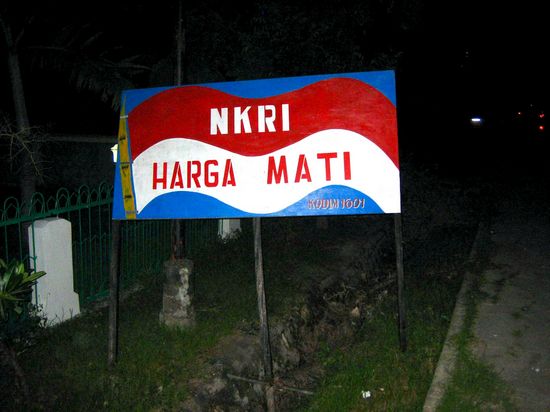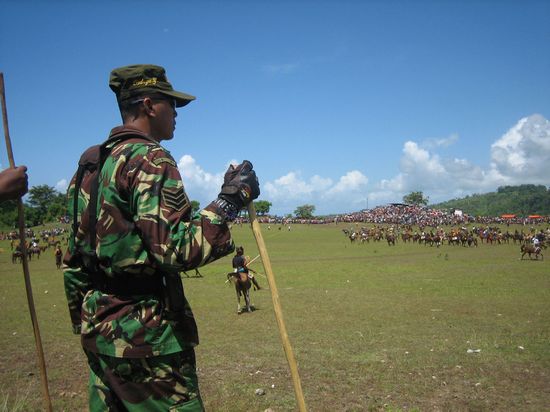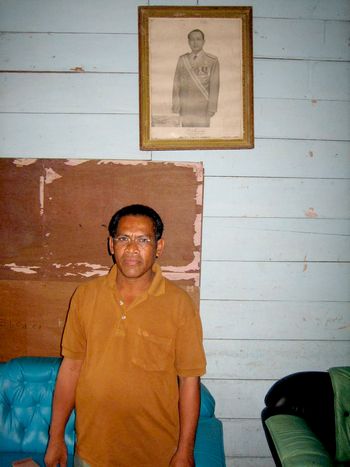Chris Lundry
Years after his downfall, reverence for Suharto is obvious in an EastSumbanese camat’s officeChris Lundry |
Travelers to Sumba might be forgiven for thinking that they had travelled back in time to the New Order period. Although throughout Indonesia opinions differ as to the legacy of Suharto, in Sumba many people, including elected officials and civil servants, seem to suffer from SARS: Sindrom Aku Rindu Suharto (I Miss Suharto Syndrome).
Sumba, an island of about 600,000 people located about mid-way between Denpasar and Kupang, is a fascinating case of the successful integration of a peripheral region into the state of Indonesia. Although Sumbanese society has attributes often linked to separatist or anti-state movements – including poverty, low levels of development, religious minority status, ethnic minority status, the presence of market dominant minorities – there is no significant organised opposition to the Indonesian state.
What is it that is keeping Sumba in the fold? The answer is complicated, but there are two important interconnected elements at work.
Persistent caste system
The first relates to the persistence of the local traditional caste system which, based on three main ‘castes’, maramba (royalty), kabihu (freemen) and ata (slaves), continues to impact Sumba society even today. The longer one spends in Sumba the more evident this lasting impact seems. While one cannot simply walk up to a sub-district head (camat) and ask him his hereditary status, through ordinary conversation a pattern emerges. These social strata are visible during ceremonies, for example, and a person’s status is a generally-known attribute. And it seems that members of the maramba caste continue to occupy most positions of power as elected officials and civil servants.
Part of the reason for this is that traditional elites were selected (or even created) by the Dutch in order to act as go-betweens with the local people, including through the creation of a Dewan Raja (Council of Kings) during the revolutionary period. As Sumba was integrated into Indonesia after the revolution, the Dewan Raja was disbanded, but its members, along with other traditional elites, generally assumed political appointments commensurate with their status.
As Suharto’s New Order began its consolidation of the state, it emphasised consistency throughout the archipelago in terms of political structure and rationalisation. Education became a requisite element of holding an elected or appointed position. In Sumba, this was no significant break with the past, as it was the elites who were most able to send their children to school. So New Order rationalisation mostly served to reinforce the social order, although it did allow for some upward mobility of the other castes.
The traditional, caste system continues to impact Sumba society even today
Of course, in many ways the persistence and impact of the traditional caste system is intertwined with, and often indistinguishable from, the operation of more contemporary class structures. But this is not surprising. As maramba have generally had greater educational and other opportunities to assure them of better class prospects, so too have ata generally had fewer opportunities and resources, with much lower class prospects.
Obviously these are broad generalisations, but the general dominance I found of maramba in elected and civil service positions, especially in East Sumba, represents tremendous continuity.
Positive experience
The second element is the positive impact the New Order had in Sumba.
Through the early years of the twentieth century, Dutch colonial law was mostly ignored in Sumba, where those with power usually prevailed. Although slave trading was banned in the Indies in 1866, the practice continued in Sumba for decades, eventually causing conflict between the slave traders, who were mostly Endenese and Bimanese, and the Dutch colonial administration. A Dutch policy of ‘pacification’ from 1908 to 1912 was meant to eliminate the slave trade, quell any resistance to the Dutch, and establish order in Sumba. A civilian administration was eventually established in 1933, but did not penetrate deeply into Sumbanese society. Despite the attempts to eliminate slavery, to some extent it still exists in Sumba, although it is not ‘plantation’ style slavery such as that in the American South, but something closer to hereditary indentured servitude. Ata are usually associated with a particular family, do not own property, and receive little by way of wages, but they work for the family and are fed and housed. Some have become educated with their maramba acting as sponsors, some have been released from their obligations, but many remain in these relationships as there are few alternatives.
 |
Value the unitary state – and most Sumbanese do!Chris Lundry |
Although the consolidation of Sumba during the Dutch period ended some uncertainty in day-to-day life in Sumba, the negative effects of this period remain – perhaps a reminder of a bad ‘pre-Suharto’ past. Slave trading affected the settlement patterns of Sumbanese, who moved inland and created villages with hedges and stone fences for defense. And to curtail mischievous behavior, children are still told stories of men who come by sea to abduct children!
During the Sukarno era little attention was paid to Sumba; regional rebellions, constantly dissolving cabinets, West Papua, Konfrontasi with Malaysia, and other travails diverted Sukarno’s attention. Probably as a result of this, the tumult experienced in other parts of Indonesia during the transition to the New Order was mostly absent from Sumba. Older Sumbanese that I spoke to who remembered this period estimated the number of communists in East Sumba during that time as less than a hundred, and Sumba was spared the widespread slaughter experienced in Java and Bali. Essentially, most people in Sumba remained disconnected from the state and politics.
But with Suharto’s ascension came a period of national consolidation, and this disconnection was to change. One of the first signs of a change in political developments in Sumba appeared as early as 1971, with the first elections held under the New Order.
While many Sumbanese retain their belief in marapu, or syncretic religious beliefs, Christianity is the dominant religion on the island – primarily Protestant, but also Catholic, especially in West Sumba. This was reflected in the success of the two main Christian parties in Sumba (Parkindo and Partai Katolik) in the previous elections of 1955. Yet by 1971 Suharto’s Golkar had already come to dominate party politics in Sumba. This ‘Golkarisation’ continued throughout and calcified over the New Order period. For Sumbanese elites, Golkar membership was their ticket up the political ladder and it allowed them access to patronage from Jakarta. Locally, this patronage flowed through these traditional elites, bolstering and reinforcing their prestige.
Paralleling this reinforcement of local elites by the New Order were positive development projects funded by Jakarta. Although this process was slow, and Sumba is still one of the least developed regions in Indonesia, within a generation the numbers of schools, sealed roads, health clinics, clean water systems, telephones, zinc roofs and other indicators of development increased.
Few resources, little interference
While receiving positive benefits from the central government, many of the negative aspects of the New Order (such as human rights abuses and the curtailing of political freedoms) were simply absent from Sumba, or irrelevant to a mostly rural and agricultural society.
 |
State authorities oversee the Pasola, ritualised mock combat in West SumbaChris Lundry |
Sumba has no significant natural resources nor any kind of significant manufacturing or industry, and thus it relies almost completely on central government funds. So feelings of exploitation common in resource rich regions of Indonesia are absent. And since Sumba did not oppose the central government, Jakarta generally took a hands-off approach to the region. There are, for example, very few soldiers stationed in Sumba, and relatively few police, especially outside of the capitals. And Sumba was the only place I encountered in New Order Indonesia where minor local officials seemed able to list a non-recognised belief system (marapu) on their identity cards.
The stricter New Order controls that did filter down suited many Sumbanese. Many believed, for example, that the coercive methods adopted by the police were effective in dissuading many thieves and criminals; horse theft in Sumba is a rite of passage in some regions. One former district head (bupati) in East Sumba bragged to me about beating farmers when he saw them idle in order to get them to work. It seems some supported this ‘tough love’ approach and productivity increased during his tenure as district head.
Reformasi or continuity?
For many Sumbanese, the events of the reformasi movement and the downfall of the New Order were traumatic. When I spoke to a number of district heads and others in 2007 I was taken by the fact that there was often a photograph of Suharto in their offices that was much larger and more prominent than that of President Susilo Bambang Yudhoyono. When I asked about this they spoke of the positive elements of the New Order, but also of the dangerous and chaotic uncertainty of 1997-98. When I pressed further they agreed that there was no chaos associated with anti-Suharto demonstrations in Sumba, but said that the images they saw on television were enough to convince them that an era of stability and security was giving way to one of uncertainty. The one, exceptional, spasm of violence at the time in West Sumba, known as the Kamis Berdarah (Bloody Thursday) incident, actually concerned clan favoritism in the civil service examinations. That aside, the passage from the New Order to the reformasi era was mostly without incident.
‘Reformasi’ is still viewed with skepticism in Sumba, while continuity is still valued
‘Reformasi,’ broadly defined, is still viewed by many with skepticism in Sumba, while continuity, also broadly defined, is still valued. That is not to say that some changes since the fall of the New Order have not received a positive response. The division of West Sumba into three new districts was well received by some in West Sumba, although others (and most East Sumbanese) criticised it as opportunism. But in general, New Order policies in Sumba served to both reinforce social continuity as well as establish conduits of authority and usher in development in such a way that the Suharto era is looked at with nostalgia. This helps to explain why there has never been a significant separatist or anti-state movement in Sumba. Rather, people seem satisfied with being a part of Indonesia, with many benefitting directly and indirectly from Jakarta’s economic support. These people credit the advances in their way of life over the last forty years to central government policy.
In a place as diverse as Indonesia, where conflict is often emphasised when describing the relationship between the state and far flung regions, it is easy to forget that Indonesian nation-building has been a tremendous success overall. What is remarkable is that that there is not more opposition.
Chris Lundry (lundry@asu.edu) is a postdoctoral fellow at the Hugh Downs School of Communication at the Arizona State University.
